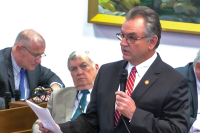Unto These Hills gets a facelift: Changes to include script rewrite, more Cherokee actors, better marketing plans, and more community involvement
By Michael Beadle
For 56 years, the outdoor historical drama known as “Unto These Hills” has been a fixture for summer tourists coming to the region looking for entertainment and a chance to learn about Cherokee history.
But in recent years, theatre attendance for the show steadily declined, and critics panned the drama as outdated, lacking Cherokee actors, and in need of a fresh marketing plan.
The Cherokee Historical Association, which oversees “Unto These Hills,” has heard these concerns loud and clear and is now in the middle of a comprehensive plan to revitalize the show, involve more Cherokees and Native Americans in the drama, and streamline the business side of the show so it remains both profitable and artistically entertaining when it opens for its 57th season on June 8.
James Bradley, the new executive director of the Cherokee Historical Association and a former Eagle dancer in “Unto These Hills, says he’s excited about all of the changes, some of which were long overdue and some of which will take time to incorporate as new leadership takes the reins.
For starters, “Unto These Hills” has a new artistic director — Hanay Geiogamah, a playwright, producer and theatre professor at the University of California at Los Angeles and director of the American Indian Dance Theatre. Geiogamah, a Kiowa/Delaware Indian from Oklahoma who is highly respected in Native American theatre, will be revising the show’s script. To ensure the cultural accuracy, he will gather input from a committee of Cherokee tribal members and the CHA board.
Related Items
The dances in the show will also be reworked to represent more of a Cherokee style rather than the ballet-type dances that have been part of the show for decades.
Other changes include doing a better job of monitoring ticket and concession stand sales, organizing community theatre opportunities in the Cherokee schools and community, using the outdoor drama venue for other shows in the off-season, and hiring an all-Native American theatre production crew which includes a new choreographer, composer, set designer, costume designer and production coordinator. In future shows, these positions will be hired as needed to rehearse the show, but once the major changes have been made, the bulk of their work will be done, Bradley explained. The overall size of the cast for this year’s show may shrink some as well — from 120 actors to 75, according to Bradley.
Farewell for some, welcome change for others
Hiring Native Americans in key positions and as actors meant letting go actors and staff long associated with the show. That has put Bradley — who is now charged with re-invigorating the show — in a precarious situation as a former member of the drama with ties to veteran cast members.
“The point is not to excommunicate people from the show,” Bradley said.
Emmett Furrow, who has been a part of the show for 17 years (most recently acting as Junaluska), said it felt like having a tooth yanked, knowing he won’t be back this season.
“They’ve cleaned house from top to bottom,” Furrow said, adding that he knew the changes were coming though he didn’t think they would come about so quickly. “I hope it works out for the best. It’s a big mystery — we don’t know what’s coming.”
Furrow said he looked forward to the three-month run of the show each summer and the camaraderie among actors that have become like a family. He still plans to keep in touch with the show’s cast, but this summer, instead of acting in “Unto These Hills,” he will be in a ghost town show in Colorado and tour as a comedian.
“I will just miss being there,” Furrow said. “The changes are a great idea.”
For McCrae Hardy, the former music director for “Unto These Hills,” it was sad to see the end of an era for the outdoor drama.
“The show was more than just a show,” said Hardy, who has been with “Unto These Hills” for almost 29 years and was responsible for all the music in the drama including the pre-show entertainment. “I know nothing lasts forever.”
Unfortunately, because of some misinterpreted comments and intense local scrutiny of the show, Hardy said there were “a lot of hurt feelings” when the changes were announced at the end of last season.
“I knew that change was imminent,” Hardy said. “It was just needlessly unpleasant.”
For many of the extended family of “Unto These Hills,” the summers at the Mountainside Theater are the only time of the year many in the cast get to see each other and catch up — as was the case for the 50th anniversary of the show several years ago. If it seems hard to part after doing one season or one show, think of that multiplied by 29 years.
Adding to the bittersweet farewell of “Unto These Hills,” Hardy also recently stepped down as music director for the North Carolina Theater in Raleigh after 22 years. He’s looking at jobs in Las Vegas, Florida and possibly New York City.
Before the cast and production changes at “Unto These Hills,” the Cherokee Historical Association underwent its own transformation. Traditionally CHA had its board members appointed for life, so there was no new blood to generate new ideas, according to Bradley. Then, in 2004, the board agreed to rewrite its bylaws, disband its board, and set up new board members that would rotate off in staggered terms of one-, two- and three-year increments. The board shrunk from 21 members to nine members, and hired Bradley in September of last year.
When the show first started, the plan was to bring in outside help to launch the drama and then train local Cherokees to continue the production.
“That never happened,” Bradley said, “and so we’re going back to the original idea.”
Who better to tell the story of the Cherokee than its own people, said CHA board member Mary Jane Ferguson.
“It’s going to be a bit of a change, but change is not always bad,” Ferguson said. For a culture that’s centuries old, she added, “This is just one little story in our evolution as a people.”
While Ferguson realizes that the entire production won’t be an all-Cherokee cast and crew, that’s the eventual goal. By creating more opportunities for theatre arts programs in Cherokee schools— perhaps establishing a local community theatre program — “Unto These Hills” will be developing a talent pool of young Cherokee actors and technical staff who can become much more involved in the outdoor drama.
For Lewis Harding, chairman of the Cherokee Historical Association’s board, the changes taking place at “Unto These Hills” represent a growing trend of Cherokee autonomy due in part to the economic engine of Harrah’s Casino that helps fund more cultural initiatives on the reservation.
“We the people are just taking back our play,” Harding said.
And while some of the previous staff and actors involved with the show may have some hurt feelings, Harding said it was not intended and not a rejection of the dedicated service that so many made to the show.
The challenge with re-scripting the play, Harding said, is to make it historically accurate, culturally authentic and dramatically entertaining. According to Harding, the first act of the three-act play is complete, and the remainder of the script is under review.
One of the criticisms from audience members was that the show was too long — people were leaving during intermission — so it is being condensed from two hours and 15 minutes to about 90 to100 minutes. In the newer version, Sequoyah will be telling the story, Harding said.
Another criticism of the play was that actors were not always heard clearly — even when they projected their lines loudly. This season, actors will be wired with microphones, Harding explained, and the theatre will be set up with Surround Sound speakers.
Tracking the dollars
Changes to the play may take several phases, and they won’t come cheap. The Cherokee Historical Association has already hired consultants to do customer research and marketing studies and to develop a five-year business plan. The Cherokee Preservation Foundation gave the CHA $1.7 million last April to improve marketing and expand the concession stand for “Unto These Hills.” In October, the Cherokee Preservation Foundation gave another $800,000 to set up a cooperative advertising program among the Museum of the Cherokee Indian, the Qualla Arts and Crafts Mutual Inc., Oconaluftee Village and “Unto These Hills” as well as hire new production staff for “Unto These Hills.” The tribe has also underwritten an $800,000 line of credit with First Citizens Bank to pay for additional costs for the production. Ticket sales from last season have paid back $300,000 of this money.
The influx of money has been great, according to Bradley, but the eventual goal is to make the outdoor drama profitable on its own.
“I want to wean us off from being totally dependent on grants,” Bradley said.
That will be part of John Tissue’s job. Tissue, the new theatre manager for “Unto These Hills,” will be tracking ticket sales using zip codes to check the demographics of customers. In the past, no studies were done to know if, for example, a certain number of repeat customers came from Georgia or how much of a candy bar was sold on a given night. Now those numbers will be tracked more carefully to get a better idea of who the customer base is and what he or she wants.
Based on Tissue’s figures, the average customer who comes to see the show, spends about $18 — $16 for the ticket, $1.50 on concessions and 50 cents on a souvenir.
“That’s really low,” Tissue said.
However, by improving the concession stand to alleviate long lines so customers get what they want quicker, that average customer may spend a little extra. If the outdoor drama can boost the average customer’s spending just $2 more, that’s an extra $110,000 a year, Tissue estimates.
“That’s significant income,” Tissue said.
There’s also talk of renovating the shows facilities — everything from the dressing rooms to cast housing to the Mountainside Theatre itself. These facilities haven’t seen renovations since the 1960s, Bradley said.
One idea might be to redo the stage to make it more available for other acts like comedians or music events that could come perform during the off-season. As it is now, nine months out of the year, the venue is empty.
“The acoustics are wonderful, the views spectacular,” Bradley said, offering up some of the selling points for the main stage.









